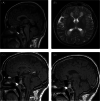Glutaric aciduria type 1: Diagnosis, clinical features and long-term outcome in a large cohort of 34 Irish patients
- PMID: 35822093
- PMCID: PMC9259398
- DOI: 10.1002/jmd2.12302
Glutaric aciduria type 1: Diagnosis, clinical features and long-term outcome in a large cohort of 34 Irish patients
Abstract
Glutaric aciduria type 1 (GA1) is a rare neurometabolic disorder that can lead to encephalopathic crises and severe dystonic movement disorders. Adherence to strict dietary restriction, in particular a diet low in lysine, carnitine supplementation and emergency treatment in pre-symptomatic patients diagnosed by high-risk screen (HRS) or newborn screen (NBS) leads to a favourable outcome. We present biochemical and clinical characteristics and long-term outcome data of 34 Irish patients with GA1 aged 1-40 years. Sixteen patients were diagnosed clinically, and 17 patients by HRS, prior to introduction of NBS for GA1 in the Republic of Ireland in 2018. One patient was diagnosed by NBS. Clinical diagnosis was at a median of 1 year (range 1 month to 8 years) and by HRS was at a median of 4 days (range 3 days to 11 years). 14/18 (77.8%) diagnosed by HRS or NBS had neither clinical manifestations nor radiological features of GA1, or had radiological features only, compared to 0/16 (0%) diagnosed clinically (p < 0.001). Patients diagnosed clinically who survived to school-age were more likely to have significant cerebral palsy and dystonia (7/11; 63.6% vs. 0/13; 0%, p < 0.001). They were less likely to be in mainstream school versus the HRS group (5/10; 50% vs. 12/13; 92.3%; p = 0.012). Clinical events occurring after 6 years of age were unusual, but included spastic diplegia, thalamic haemorrhage, Chiari malformation, pituitary hormone deficiency and epilepsy. The exact aetiology of these events is unclear.
Keywords: gluatric aciduria type 1; high‐excretor; high‐risk screen; low‐excretor; newborn screening; retrospective analysis.
© 2022 The Authors. JIMD Reports published by John Wiley & Sons Ltd on behalf of SSIEM.
Conflict of interest statement
The authors declare no conflict of interest.
Figures


Similar articles
-
Extrastriatal changes in patients with late-onset glutaric aciduria type I highlight the risk of long-term neurotoxicity.Orphanet J Rare Dis. 2017 Apr 24;12(1):77. doi: 10.1186/s13023-017-0612-6. Orphanet J Rare Dis. 2017. PMID: 28438223 Free PMC article.
-
Impact of interventional and non-interventional variables on anthropometric long-term development in glutaric aciduria type 1: A national prospective multi-centre study.J Inherit Metab Dis. 2021 May;44(3):629-638. doi: 10.1002/jimd.12335. Epub 2020 Dec 15. J Inherit Metab Dis. 2021. PMID: 33274439
-
The low excretor phenotype of glutaric acidemia type I is a source of false negative newborn screening results and challenging diagnoses.JIMD Rep. 2021 Apr 5;60(1):67-74. doi: 10.1002/jmd2.12217. eCollection 2021 Jul. JIMD Rep. 2021. PMID: 34258142 Free PMC article.
-
Impact of newborn screening and quality of therapy on the neurological outcome in glutaric aciduria type 1: a meta-analysis.Genet Med. 2021 Jan;23(1):13-21. doi: 10.1038/s41436-020-00971-4. Epub 2020 Sep 28. Genet Med. 2021. PMID: 32981931 Free PMC article.
-
Inherited Disorders of Lysine Metabolism: A Review.J Nutr. 2020 Oct 1;150(Suppl 1):2556S-2560S. doi: 10.1093/jn/nxaa112. J Nutr. 2020. PMID: 33000154 Review.
Cited by
-
Outcomes of deep brain stimulation surgery in the management of dystonia in glutaric aciduria type 1.J Neurol. 2025 Mar 1;272(3):234. doi: 10.1007/s00415-025-12942-3. J Neurol. 2025. PMID: 40025312 Free PMC article.
-
Glutaryl-CoA Dehydrogenase Misfolding in Glutaric Acidemia Type 1.Int J Mol Sci. 2023 Aug 24;24(17):13158. doi: 10.3390/ijms241713158. Int J Mol Sci. 2023. PMID: 37685964 Free PMC article.
-
Lipoyl deglutarylation by ABHD11 regulates mitochondrial and T cell metabolism.Nat Chem Biol. 2025 Jul 15. doi: 10.1038/s41589-025-01965-6. Online ahead of print. Nat Chem Biol. 2025. PMID: 40664791
-
Glutaric Aciduria Presenting With an Acute Encephalitic Crisis: A Case Report.Cureus. 2024 Jul 30;16(7):e65722. doi: 10.7759/cureus.65722. eCollection 2024 Jul. Cureus. 2024. PMID: 39211641 Free PMC article.
-
Glutaric aciduria and L-2-hydroxyglutaric aciduria: Clinical and molecular findings of 35 patients from Turkey.Mol Genet Metab Rep. 2023 May 23;36:100979. doi: 10.1016/j.ymgmr.2023.100979. eCollection 2023 Sep. Mol Genet Metab Rep. 2023. PMID: 37275239 Free PMC article.
References
-
- Stenson PD, Ball EV, Mort M, et al. Human Gene Mutation Database (HGMD®): 2003 update. Hum Mutat. 2003;21(6):577‐581. - PubMed
-
- Naughten ER, Mayne PD, Monavari AA, Goodman SI, Sulaiman G, Croke DT. Glutaric aciduria type I: outcome in the Republic of Ireland. J Inherit Metab Dis. 2004;27(6):917‐920. - PubMed
-
- Kölker S, Garbade SF, Boy N, et al. Decline of acute encephalopathic crises in children with glutaryl‐CoA dehydrogenase deficiency identified by newborn screening in Germany. Pediatr Res. 2007;62(3):357‐363. - PubMed
-
- Boy N, Mühlhausen C, Maier EM, et al. Proposed recommendations for diagnosing and managing individuals with glutaric aciduria type I: second revision. J Inherit Metab Dis. 2017;40(1):75‐101. - PubMed
LinkOut - more resources
Full Text Sources
Research Materials
Miscellaneous

